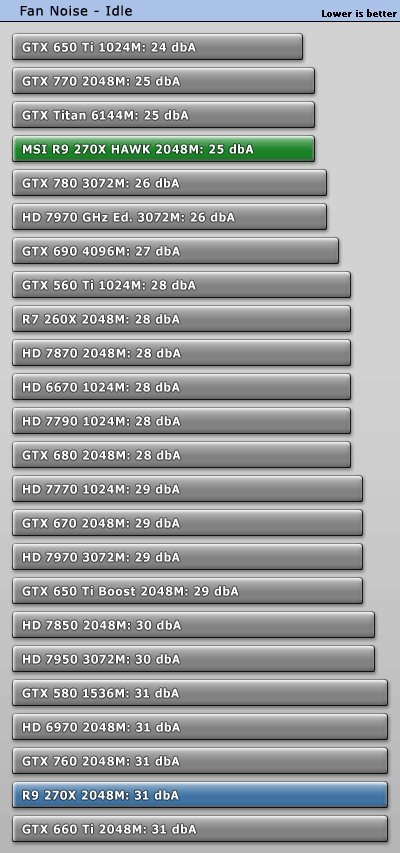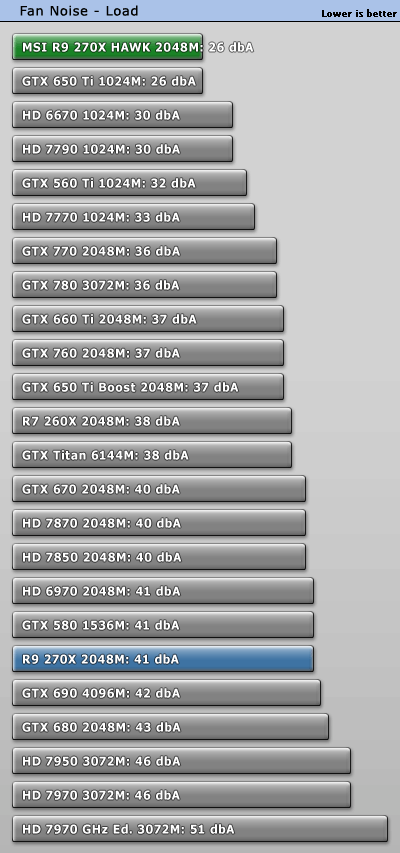 9
9
MSI R9 270X HAWK 2 GB Review
Performance Summary »Fan Noise
In past years, gamers would accept everything for a little bit more performance. Nowadays, users are more aware of the fan noise and the power consumption of their graphics cards.We use the Bruel & Kjaer 2236 sound-level meter (~$4,000) to properly test the fan noise a card emits. It has the measurement range and accuracy we are looking for.

The tested graphics card was installed in a system that was completely cooled system passively. That is, passive PSU, passive CPU cooler, and passive cooling on the motherboard and a solid state drive. Noise results of other cards on this page are measurements of the respective reference design.
This setup allows us to eliminate secondary noise sources and test only the video card. To be more compliant with standards like DIN 45635 (we are not claiming to be fully DIN 45635 certified), the measurement was conducted at a distance of 100 cm and 160 cm off the floor. Ambient background noise in the room was well below 20 dBA for all measurements. Please note that the dBA scale is not linear but logarithmic. 40 dBA is not twice as loud as 20 dBA, as a 3 dBA increase results in double the sound pressure. The human hearing perception is a bit different, and it is generally accepted that a 10 dBA increase doubles the perceived sound level. 3D load noise levels were tested with a stressful game, not with Furmark.
Fan noise in both idle and load is very, very good. The card is probably the quietest card in its performance segment. In idle, the fan is inaudible when installed in a case with other actively cooled components. When gaming, the fan ramps up just a little bit to handle the extra heat, but still stays nearly inaudible.


Jul 25th, 2025 17:52 CDT
change timezone
Latest GPU Drivers
New Forum Posts
- EVGA 3080ti crashing w/in 20 mins in GPU intensive games, but only in my new AMD build despite running cooler (15)
- Intel cpu Ark website database gone? (8)
- Kindly help me to complete my new PC build... (9)
- Budget friendly upgrading from 970? (1)
- Samsung 870 EVO - Beware, certain batches prone to failure! (1277)
- Corsair RM850x (2021) 12V Rail Dropping — Causing Crashes While Gaming (39)
- Motherboard Recommendation ? (3)
- R-T-B's house of Hisense Firmware (35)
- Intel I7-12700F TPL settings help (0)
- Does a bigger case actually run quieter if you’re using the same number of fans? (3)
Popular Reviews
- Noctua NF-A12x25 G2 PWM Fan Review
- MSI MPG B850I Edge Ti Wi-Fi Review
- UPERFECT UMax 24 Review
- Cougar OmnyX Review
- TerraMaster F4-424 Max Review - The fastest NAS we've tested so far
- VAXEE XE V2 Wireless Review
- Sharkoon OfficePal C10 Review - Affordable and Decent
- Thermal Grizzly WireView Pro Review
- Upcoming Hardware Launches 2025 (Updated May 2025)
- Lian Li O11 Dynamic Mini V2 Review
TPU on YouTube
Controversial News Posts
- Some Intel Nova Lake CPUs Rumored to Challenge AMD's 3D V-Cache in Desktop Gaming (140)
- AMD Radeon RX 9070 XT Gains 9% Performance at 1440p with Latest Driver, Beats RTX 5070 Ti (131)
- AMD's Upcoming UDNA / RDNA 5 GPU Could Feature 96 CUs and 384-bit Memory Bus (122)
- NVIDIA GeForce RTX 5080 SUPER Could Feature 24 GB Memory, Increased Power Limits (115)
- NVIDIA DLSS Transformer Cuts VRAM Usage by 20% (99)
- AMD Sampling Next-Gen Ryzen Desktop "Medusa Ridge," Sees Incremental IPC Upgrade, New cIOD (97)
- NVIDIA Becomes First Company Ever to Hit $4 Trillion Market-Cap (94)
- Windows 12 Delayed as Microsoft Prepares Windows 11 25H2 Update (92)
